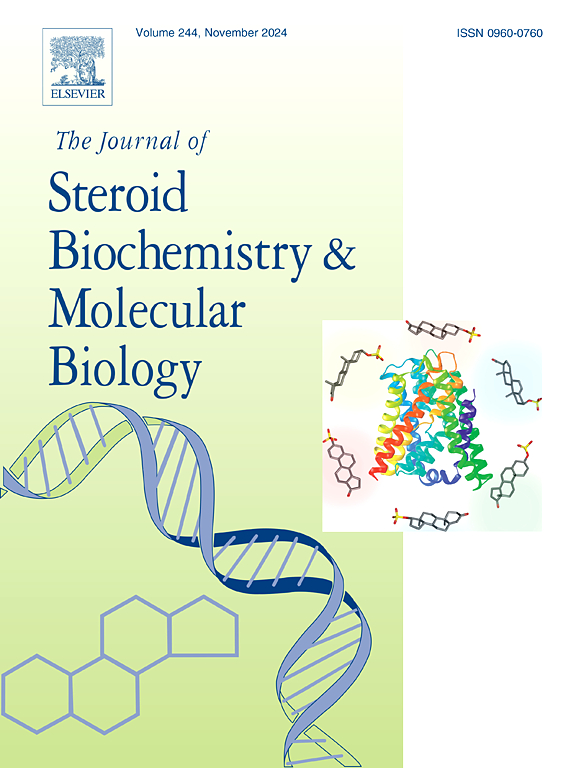根据血清类固醇激素对多囊卵巢综合征进行生化分类诊断。
IF 2.7
2区 生物学
Q3 BIOCHEMISTRY & MOLECULAR BIOLOGY
Journal of Steroid Biochemistry and Molecular Biology
Pub Date : 2024-10-23
DOI:10.1016/j.jsbmb.2024.106626
引用次数: 0
摘要
多囊卵巢综合征(PCOS)是一种代谢性疾病,具有临床异质性。由于缺乏诊断标志物,患有非高雄激素血症(NA)的多囊卵巢综合征女性可能会被误诊。本研究旨在系统分析高雄激素血症(HA)与非高雄激素血症 PCOS 女性之间类固醇激素的差异,并筛选 PCOS 的分类诊断模型。研究采用 LC-MS/MS 方法,对 54 名 HA-多囊卵巢综合征、79 名 NA-多囊卵巢综合征和 60 名对照组(非多囊卵巢综合征)18 至 35 岁女性的血清样本进行了综合类固醇激素靶向定量检测。分析了多囊卵巢综合征和非多囊卵巢综合征女性血清中雄激素、皮质类固醇、孕激素和类固醇激素生物合成途径中雌激素的水平。对线性判别分析(LDA)、K-近邻(KNN)、助推逻辑回归(LogitBoost)、Naive Bayes(NB)、C5.0 算法(C5)、随机森林(RF)、支持向量机(SVM)和神经网络(NNET)等八种机器学习方法进行了评估和选择,以对多囊卵巢综合征进行分类诊断。对训练集进行了 10 倍交叉验证。从胆固醇到下游类固醇激素的整个代谢通量在多囊卵巢综合征中显著增加,尤其是在 HA-POCS 妇女中。由于 RF 模型的平均准确率最高(0.938,p<0.05),因此被选为 HA-PCOS、NA-PCOS 和非 PCOS 妇女的分类诊断模型。本文章由计算机程序翻译,如有差异,请以英文原文为准。
Biochemical classification diagnosis of polycystic ovary syndrome based on serum steroid hormones
Polycystic ovary syndrome (PCOS) is a metabolic disorder with clinical heterogeneity. PCOS women with non-hyperandrogenemia (NA) might be misdiagnosed due to a lack of diagnostic markers. This study aims to systematically analyze the differences in steroid hormones between PCOS women with hyperandrogenemia (HA) and NA, and to screen classification diagnosis models for PCOS. The serum samples from 54 HA-PCOS, 79 NA-PCOS and 60 control women (Non-PCOS) aged between 18 and 35 were measured by an integrated steroid hormone-targeted quantification assay using LC-MS/MS. The levels of serum androgens, corticosteroids, progestins and estrogens in the steroid hormone biosynthesis pathway were analyzed in PCOS and Non-PCOS women. Eight machine learning methods including Linear Discriminant Analysis (LDA), K-nearest Neighbors (KNN), Boosted Logistic Regression (LogitBoost), Naive Bayes (NB), C5.0 algorithm (C5), Random Forest (RF), Support Vector Machines (SVM), and Neural Network (NNET) were performed, evaluated and selected for classification diagnosis of PCOS. A 10-fold cross-validation on the training set was performed. The whole metabolic flux from cholesterol to downstream steroid hormones increased significantly in PCOS, especially in HA-POCS women. The RF model was chosen for the classification diagnosis of HA-PCOS, NA-PCOS, and Non-PCOS women due to the maximum average accuracy (0.938, p<0.001), AUC (0.989, p<0.001), and kappa (0.906, p<0.001), and the minimum logLoss (0.200, p<0.001). Five steroid hormones including testosterone, androstenedione, total 2-methoxyestradiol, total 4-methoxyestradiol, and free estrone were selected as the decision trees for the simplified RF model. A total of 37 women were included in the validation set. The diagnostic sensitivity for HA-PCOS, NA-PCOS, and Non-PCOS was 100 %, 93.3 % and 91.7 %, respectively. HA-PCOS, NA-PCOS, and Non-PCOS women showed obvious different steroid hormone profiles. The simplified RF model based on two androgens and three estrogens could be effectively applied to the classification diagnosis of PCOS, further reducing the missed diagnosis rate of NA-PCOS.
求助全文
通过发布文献求助,成功后即可免费获取论文全文。
去求助
来源期刊
CiteScore
8.60
自引率
2.40%
发文量
113
审稿时长
46 days
期刊介绍:
The Journal of Steroid Biochemistry and Molecular Biology is devoted to new experimental and theoretical developments in areas related to steroids including vitamin D, lipids and their metabolomics. The Journal publishes a variety of contributions, including original articles, general and focused reviews, and rapid communications (brief articles of particular interest and clear novelty). Selected cutting-edge topics will be addressed in Special Issues managed by Guest Editors. Special Issues will contain both commissioned reviews and original research papers to provide comprehensive coverage of specific topics, and all submissions will undergo rigorous peer-review prior to publication.

 求助内容:
求助内容: 应助结果提醒方式:
应助结果提醒方式:


